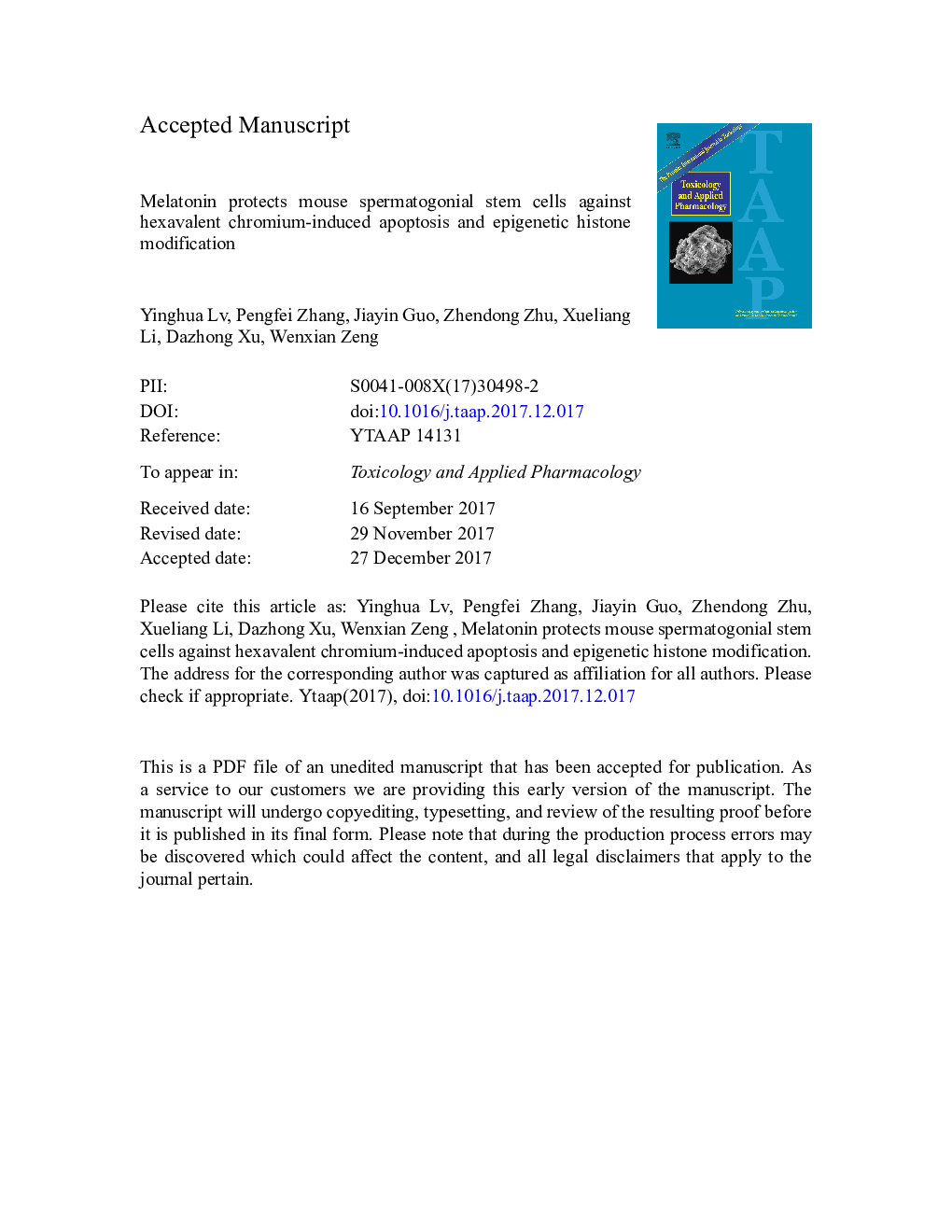| کد مقاله | کد نشریه | سال انتشار | مقاله انگلیسی | نسخه تمام متن |
|---|---|---|---|---|
| 8538880 | 1561122 | 2018 | 39 صفحه PDF | دانلود رایگان |
عنوان انگلیسی مقاله ISI
Melatonin protects mouse spermatogonial stem cells against hexavalent chromium-induced apoptosis and epigenetic histone modification
ترجمه فارسی عنوان
ملاتونین سلول های بنیادی اسپرماتوگونیال موش را در برابر آپوپتوز ناشی از کروم شش ظرفیتی و اصلاح هیستون های اپی ژنتیکی محافظت می کند
دانلود مقاله + سفارش ترجمه
دانلود مقاله ISI انگلیسی
رایگان برای ایرانیان
کلمات کلیدی
CCK-8Histone H3 lysine 9 trimethylationDSBH3K9me3KDM3AHistone H3 lysine 27 trimethylationSSCsH3K27me3eSETPLZFJC-1ROS - ROSpromyelocytic leukemia zinc finger - انگلی روی لوکمی پرولیلوسیتیکEpigenetic - اپی ژنتیکTUNEL - تونلApoptosis - خزان یاختهایSpermatogonial stem cells - سلول های بنیادی اسپرماتوگونالیcell counting kit-8 - شمارش سلول کیت 8DNA double strand break - شکست دو رشته DNAMelatonin - ملاتونینMouse - موشhematoxylin-eosin - هماتوکسیلین ائوزینPropidium iodide - پروتئین یدیدCr(VI) - کروم (VI)Reactive oxygen species - گونههای فعال اکسیژن
موضوعات مرتبط
علوم زیستی و بیوفناوری
علوم محیط زیست
بهداشت، سم شناسی و جهش زایی
چکیده انگلیسی
Given the potential biological functions of spermatogonial stem cells (SSCs) in spermatogenesis and in delivering parental genetic information to the next generation, how these cells respond to environmental toxins and carcinogens should be investigated. We examined the toxic effect of hexavalent chromium (Cr(VI)) on global histone modifications and apoptotic signaling pathways in SSCs. We determined the effect of melatonin, one of the most powerful endogenous free radical scavengers and wide-spectrum antioxidants, in protecting SSCs from Cr(VI)-induced apoptosis and global histone modification by Western blot analysis. In addition, we examined the in vivo effect of melatonin on Cr(VI)-induced histological changes of seminiferous tubules in mouse testes. We also evaluated the fertility of male mice by monitoring litter size following intraperitoneal injection of these chemicals. Our study demonstrated the Cr(VI)-induced global increases in H3K9me3 and H3K27me3 and activated the apoptotic signaling pathway. Pretreatment of SSCs with melatonin alleviated Cr(VI)-induced apoptosis and the global increase of H3K9me3. Exposure to melatonin also attenuated the Cr(VI)-induced increase of the abundance of histone methyltransferase ESET. Furthermore, exogenous administration of melatonin protected mice against Cr(VI)-induced changes in testicular histology and germ cell apoptosis, which helped maintain normal spermatogenesis and male fertility. Our study revealed a potential new therapeutic approach for male reproductive injury caused by Cr(VI).
ناشر
Database: Elsevier - ScienceDirect (ساینس دایرکت)
Journal: Toxicology and Applied Pharmacology - Volume 340, 1 February 2018, Pages 30-38
Journal: Toxicology and Applied Pharmacology - Volume 340, 1 February 2018, Pages 30-38
نویسندگان
Yinghua Lv, Pengfei Zhang, Jiayin Guo, Zhendong Zhu, Xueliang Li, Dazhong Xu, Wenxian Zeng,
